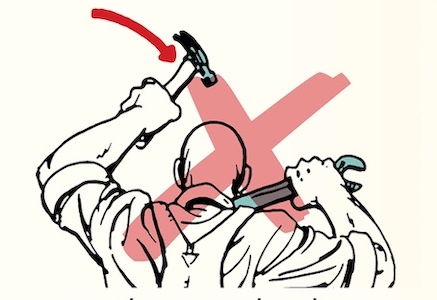
The Allen wrench is one of those things that is so ubiquitous you’re apt to take it for granted.
I’ve got a bunch of these L-shaped pieces of metal distributed all over my house. There’s an Allen wrench on top of my dresser. There’s one in my bathroom cabinet. There are a few stashed in my office desk. And my junk drawer runneth over with them.
For some reason, the Allen wrench sitting on my bedroom dresser grabbed my attention this morning and got me wondering, “What’s this thing’s story? Why do I have so many of these wrenches lying around? Why is it so satisfying to fasten screws with one?”
So I started investigating.
Here’s what I learned about this omnipresent, incredibly-handy-but-typically-underrated tool.
The History of the Allen Wrench (aka the Hex Key)
Screws have been around for thousands of years, but it wasn’t until the industrialization of the 19th century that they became a standard fastener. The first screws had a slot head/flathead, and you would use a flathead screwdriver to drive the screw into wood. The downside of slotted screws is that the screwdriver tends to slip out of the slot, especially as you apply more torque, leaving you with a stripped screw.
Seeing this issue, innovative Americans between the 1860s and 1890s started to design screws that had square- or triangular-shaped sockets. Instead of only having a single contact surface between the socket and the screwdriver, square or triangular sockets gave you three or four contact surfaces. More contact surfaces = reduced chances of driver slippage.
While the patents for screwheads with square or triangular sockets were filed in the 19th century, it wasn’t until 1908 that the first commercialized square socket hit the market. They didn’t attract much attention.
Then sometime between 1909 and 1910, an American named William G. Allen patented a screwhead with a six-sided hexagonal shape and accompanying hexagonal driver, called a hex socket key. His company, the Allen Manufacturing Company of Hartford, Connecticut, began marketing this new screw as the “Allen Safety Screw.”
In 1911, another outfit — the Standard Pressed Steel Company — created their own version of the hex socket screw and accompanying hexagonal driver. According to the company’s telling of events, their creation of the hexagonal socket and driver was simultaneous with and independent of the invention of the Allen Safety Screw. Other inventors in other countries appear to have independently invented versions of the hex head screw and driver around the same time as well. It must have been an idea whose time had come.
Likely driving the push towards the hex head was the industrial safety campaigns of the Progressive movement. The hex head was seen as a safer alternative to traditional slot head screws since they minimized the slipping of drivers. Also, the design allowed for the creation of headless or recessed screws, which reduced the chances of a worker’s clothing catching a screw head and getting pulled into the line shafting that was commonly used in early 20th century factories.
Despite the benefits of the hex head screw, it was slow to take off. It wasn’t until World War II and America’s creation of the “arsenal of democracy” that they came into widespread use.
After the war, hex head screws became ubiquitous in all sorts of machines like cars, bikes, and motorcycles. In the late 1950s, IKEA pioneered the concept of ready-to-assemble, “flat pack” furniture, which was to be fastened together by the customer using hex screws. Given how cheap they were to make, the company supplied an L-shaped hex socket key in the packaging, so that a customer could put together their purchased furniture without having to own any tools themselves. The idea, of course, caught on with the makers of all kinds of ready-to-assemble household goods.
In most countries, the driver used to screw in a hex head screw is today called a hex key. But in the United States, Canada, the United Kingdom, and Australia, the hex key is typically called an “Allen key” or “Allen wrench,” harkening back to the company that introduced this tool.
The Benefits of the Allen Wrench/Hex Key
The hex socket and key have a few benefits over traditional slot head or Phillips head screws and screwdrivers.
The main benefit is that the hex socket provides six contact surfaces between it and its key. More contact surfaces means less chance of slipping and stripping while driving. This set-up may also be why securing a screw with an Allen wrench, rather than a standard driver, feels strangely more satisfying.
The Allen wrench is also a versatile tool. Either end of the L-shaped hex key can be used to drive a screw. If you need more torque, stick the short end of the hex key (the horizontal bottom of the L) into the socket of a screw and use the long end as a lever. If you need to put a screw into a hard-to-reach spot, stick the long end of the hex key into its socket, and use the short end to turn the wrench.
Even Though Your Flat-Pack Furniture Comes With an Allen Key, Get Your Own Sets
Allen wrenches/screws come in varying sizes, and while you likely have a broad spectrum of them lying around your house from all the furniture you’ve put together over the years, it’s a good idea to have your own, “official” set.
Why?
For starters, the flat-pack furniture you bought might be missing a hex key. I’ve had this happen to me a few times. The package list says there’s supposed to be an Allen wrench, but there’s no Allen wrench. If I didn’t have my own set of hex keys, unless I happened to have the right size of wrench lying around, I wouldn’t have been able to put together that piece of furniture.
Second, having your own set of hex keys allows you to not only put a piece of furniture together, but also take it apart down the line. If, after you finished assembling something, you accidentally tossed the wrench along with the rest of the packaging into the trash, what are you going to do if you later need to dismantle the piece in order to move it?
I had this happen to me a few years ago when it was time to replace our youngest’s crib with a bed. I had to disassemble her crib to get it out of the room. The crib used hex screws, but I had thrown away the original hex key that came with it, so I had to use one from my own set.
If you own a bike, most everything on it is fastened together with hex screws. So if you want to do any maintenance on it yourself, you’re going to need a set of Allen wrenches.
Since hex keys are cheap to make, a set of them is pretty dang affordable. You can get a 30-piece set that includes SAE and metric sizes for just $30. The trick with having your own set of hex keys is to avoid treating them like the hex keys that get packed with your furniture; after you’ve used one, make sure to put it back in its case rather than throwing it in a junk drawer.
Besides the set packed in a case, I also have a foldable set, where Allen wrenches of varying sizes are bundled together in a pocket-knife-like fashion. You flip out the size you need and then fold it back up when you’re done. If you’re an avid cyclist, this is one of the tools you ought to keep in a pouch on your bike.
Well, there you go — the past and present of the Allen wrench. Now that you’ve gotten to know more about this humble-yet-handy tool, hopefully you’ll have a bit more appreciation for it the next time you see that L-shaped piece of metal in your junk drawer.







